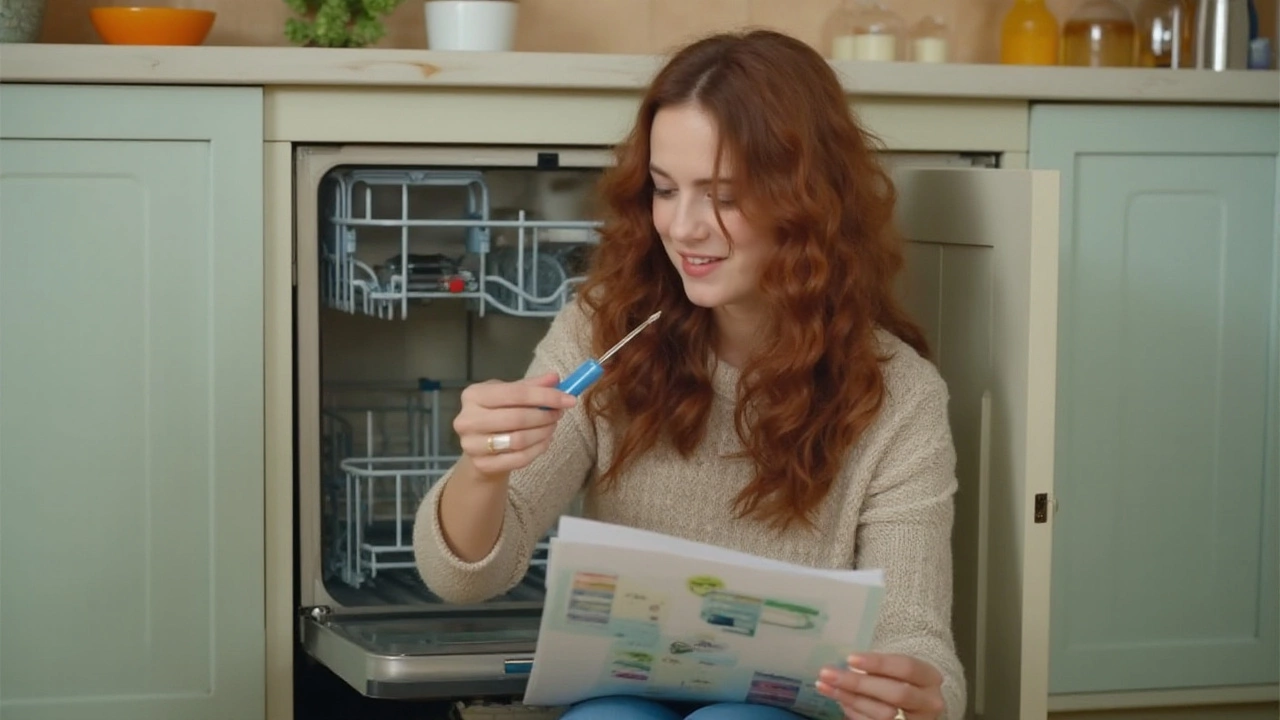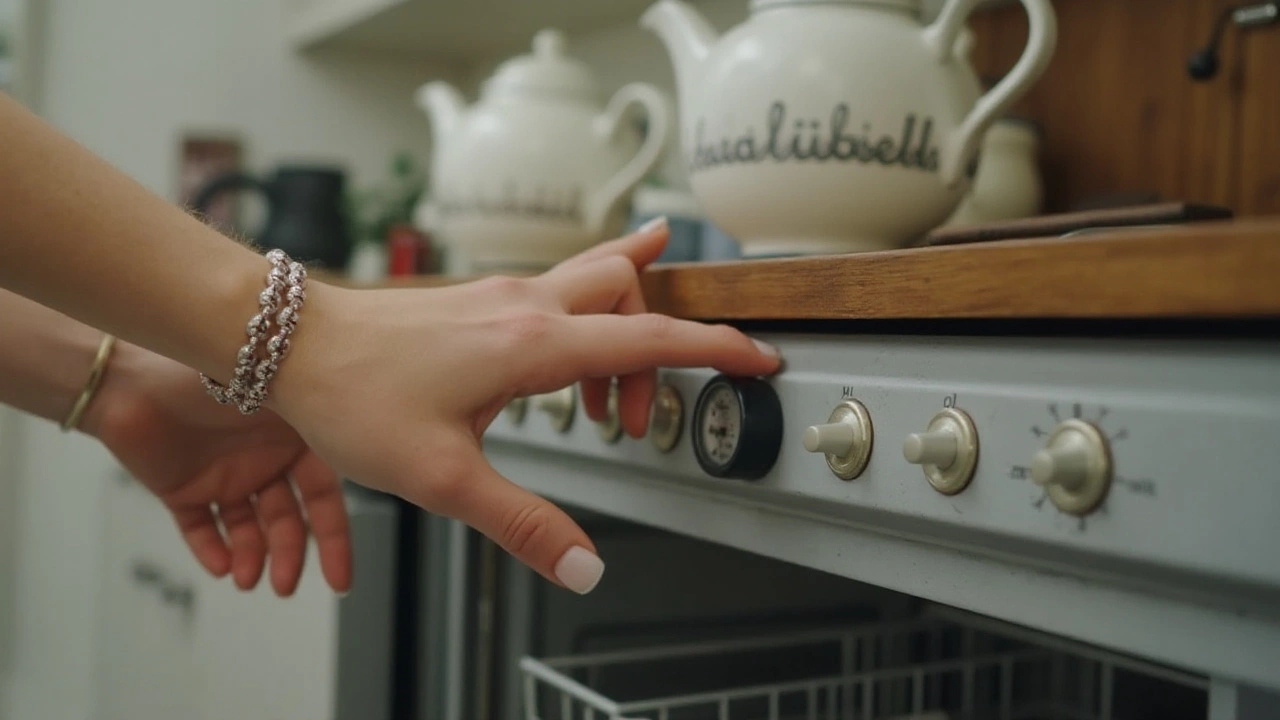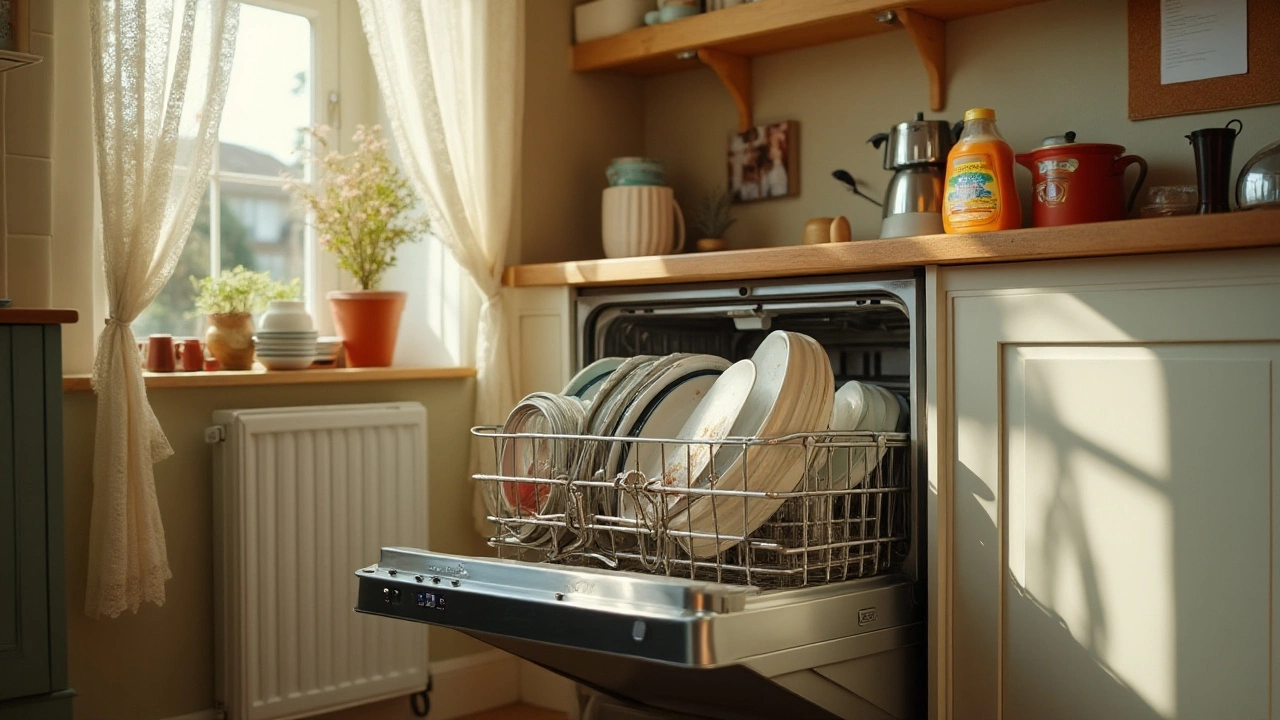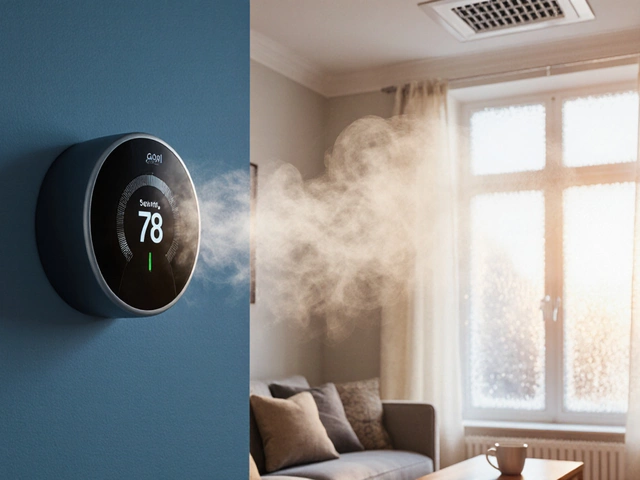Dishwashers have become an indispensable ally in modern kitchens, taking on the often thankless task of cleaning up after family meals. But like all machines, they can sometimes strike a discordant note, particularly when issues arise unexpectedly. Whether it's water that won't drain or dishes emerging less than spotless, these hiccups can interrupt your routine.
Understanding the bumps in the road is the first step to getting them sorted out. Not everyone needs to rush to the phone and get a repair technician on the line. Learning about the basic components and common malfunctions can empower you to handle minor repairs with minimal effort, keeping your dishwasher humming along nicely. Let's dive into these simple solutions and how you can implement them to ensure your reliable kitchen companion stays in top shape.
- Understanding Common Dishwasher Problems
- Essential Tools for Dishwasher Repair
- Step-by-step Troubleshooting Guide
- When to Call in a Professional
- Maintenance Tips to Avoid Future Issues
Understanding Common Dishwasher Problems
Our modern kitchens thrive on the efficiency of dishwashers, but when they act out, it can disrupt the tranquil rhythm we've come to enjoy. The curious part is that many of these hiccups stem from fairly routine issues, often solvable with a bit of insight and elbow grease. At the heart of many dishwasher repair calls are problems like water not draining properly, dishes not coming out clean, or strange noises emanating from the depths of the machine. Let's look closer at these quirky deviations.
The issue of standing water at the bottom of the machine is quite common. When a dishwasher fails to drain, many people's first thought is to call a professional. But, this is often linked to minor blockages or a clogged filter. Ensuring the filter is clear of food debris and checking the drainage hose for kinks or clogs can often solve the problem. It's akin to finding a small pebble in your shoe that's been causing discomfort as you walk.
Then there's the matter of dishes not coming out clean, another frequent complaint among users. This problem can sometimes be chalked up to simple issues like overcrowding the dishwasher or not pre-rinsing particularly sticky or greasy dishes. However, it might also suggest that the spray arms are not functioning properly, perhaps clogged with hard water deposits or food residue. Inspecting and cleaning these arms can make a significant difference.
According to experts at Consumer Reports, "Regular maintenance and attentive use can significantly reduce the occurrence of common dishwasher issues." This advice underscores the importance of understanding your appliance and adopting practices that encourage its longevity.
No one wants to hear clunking or grinding noises while their dishwasher is running, which can set the stage for some unnerving moments. This issue might be a signal of something benign, like dishes rattling against each other, or it could hint at worn-out motor bearings, which might require more attention. Understanding the nuance in these sounds can prevent minor issues from turning into costly repairs.
Common Dishwasher Malfunctions
Several dishwasher problems are more prevalent than others. By knowing them, you can keep your appliance in good health without extensive help. Let's outline some typical malfunctions:
- Water not draining: Check for food particles in the filter or drainage hose issues.
- Unclean dishes: Avoid overcrowding and clean spray arms regularly.
- Strange noises: Ensure dishes are properly placed and inspect motor bearings if needed.
- Cycle not completing: This might be due to faulty door latches or electronic control malfunctions.
- Leaking water: Inspect door seals and gaskets for any signs of wear.
By recognizing these common faults, many owners find that they can do a fair amount of the troubleshooting themselves, bringing about a renewed sense of comfort in using their trusty home appliance. With the right blend of care and curiosity, keeping your dishwasher in prime working order is easier than one might initially think.
Essential Tools for Dishwasher Repair
Fixing dishwashers might sound daunting, but with the right collection of tools, tackling the common issues becomes manageable. Much like a chef wouldn't step into a kitchen without a trusty set of knives, anyone aiming to repair dishwashers should have a set of essential tools at their disposal. A simple but sturdy set of screwdrivers, for example, will always prove invaluable. Most dishwashers shut tight with screws that can wear over time, making them more challenging to remove. So, having both Phillips and flat-head screwdrivers on hand allows you to handle any variety that might come your way.
Next is the multimeter, an indispensable tool for your dishwasher repair arsenal. Because many problems come down to faulty wiring or components, this device lets you pinpoint exactly where electricity is not flowing as it should. By carefully reading the manual and understanding how to test various points, it's possible to uncover hidden issues. In many DIY circles, the power of a multimeter is revered, as stated by appliance expert John Smith in his article, "Testing Before Tossing," where he noted,
"A multimeter isn't just a tool; it's a roadmap to electrical enlightenment."
A wire stripper and electrical tape are also critical when tackling dishwasher repairs. The inner circuitry of dishwashers frequently requires rewiring to restore function after certain repairs or replacements. In these situations, the ability to swiftly strip and reconnect wires with skill and confidence can ensure a safe and lasting resolution. Always have an assortment of wire connectors available, as they often serve as the backbone of these quick fixes.
Let's not forget the humble wrench set, often overlooked but vital. The internals of most dishwashers are tightly secured, relying on a network of nuts and bolts. Adjusting, loosening, or removing these components requires the precision only a well-fitted wrench can deliver. An adjustable wrench, which can fit a range of nut sizes, provides flexibility and allows one to tackle multiple jobs without needing a whole set.
While not a tool per se, having the manufacturer's manual on hand is an invaluable asset. This manual often includes detailed breakdowns of your specific model and tips specifically for your unit’s maintenance and reparation. Clear diagrams and troubleshooting steps offer insight that might not be obvious just by opening the machine and peering inside.
In this practical pursuit of effective dishwasher repair, a well-stocked toolbox saves time and energy. Instead of fumbling around, you can focus on diagnosing and fixing the problem efficiently, keeping your trusty appliance in prime working order for many meals to come. Remember, the right tool at the right moment can be the difference between a temporary fix and a lasting solution.

Step-by-step Troubleshooting Guide
When your dishwasher decides to give you grief, it can feel like your kitchen companion is betraying you. Fear not, for many problems are simple to solve with just a bit of insight and guidance. First and foremost, always unplug the appliance or switch off the circuit breaker to your machine before you commence any troubleshooting. This important step ensures safety to you and respects the electric spirit of your kitchen appliances. With that said, let’s embark on this adventure of dishwasher repair.
Step 1: Check the Power
The first issue to look into is whether your dishwasher is even receiving power. Begin by ensuring it’s plugged in properly, as vibrations during operation can sometimes loosen a connection. Next, check the circuit breaker or fuse box; it’s not uncommon for a dishwasher to trip a breaker, especially if it shares a circuit with heavy-draw appliances. If everything seems in order and there’s still no life, examine if the door latch is truly secure; most dishwashers refuse to run unless the door is tightly closed. A faulty door latch switch can deceive the machine into thinking it's still open.
Step 2: Water Supply Issues
Without water, a dishwasher is as useful as a sieve in a desert. If your dishes are dry and dusty, investigate the water source. Make sure the water valve serving the dishwasher is fully open. If you’re not sure where this is, trace the supply hose from the back of the dishwasher; at some point, it will meet the valve. Additionally, check the hose itself. It should be free of kinks or breaks. If water is pooling at the bottom, the issue might be a clogged filter or a blocked drain hose. Regular maintenance checks can prevent these common issues, so be proactive!
Step 3: Look at the Wash Arms
When dishes come out still speckled with last night's spaghetti sauce, the source of discontent might be the spray arms. These marvelous rotating devices must spin freely and be unobstructed by poorly loaded dishes. Over time, small bits of debris or hard water deposits can pursue residency in the spray jets. Remove the arms and use a toothbrush or a straightened paperclip to clear any blockage. Inspect if the arms rotate freely upon reinstallation. Regular cleanup can enhance their efficiency tremendously.
Step 4: Assess the Detergent Dispenser
The job of the detergent dispenser is more complex than meets the eye. If it's malfunctioning, your dishes won't get the cleaning they require, no matter how hot the water is. Check that the dispenser is not overfilled or blocked by large items in the racks. Sometimes the dispenser door can be sticky due to residue buildup, so a gentle cleaning with a damp cloth can work wonders. In the case of persistent issues, replacing the dispenser might be necessary.
“In most cases, DIY dishwasher repairs are not just feasible—they’re satisfying!” said Brian Stevens, a professional appliance technician, noting the simplicity behind many fixes.
Step 5: Evaluate the Drain System
If you’re facing issues such as water not draining properly, it's wise to inspect the drain system. The filter and the basket within the dishwasher must be clear of any food particles or gunk. Taking a moment to clean these components every so often can make a world of difference in keeping your machine running smoothly. Look at the drain hose too; make sure it’s connected properly and free from any apparent obstructions. A bend or blockage can significantly hinder the draining process, and a faulty drain valve lever might require a professional touch.
Armed with these steps, conquering minor dishwasher repair challenges can become an achievable feat. Indeed, understanding these mechanical mysteries not only saves dollars but also imbues a sense of mastery over household affairs.
When to Call in a Professional
While many dishwasher repairs can be tackled with a bit of patience and the right tools, there comes a time when calling in the experts is the best course of action. One telltale sign that you need professional assistance is if you've tried troubleshooting and your dishwasher still refuses to cooperate. In such cases, the issue might be more complex, involving electrical faults or specific mechanical failures that require advanced knowledge and specialized equipment. Additionally, if you feel uncertain or uncomfortable with making the repairs yourself, err on the side of caution. Sometimes, the cost of a service call is worth the peace of mind knowing the job will be done safely and correctly.
For example, if your dishwasher is leaking, the problem could be more than a simple gasket replacement. Signs of water damage on the floor or walls could indicate a more significant issue with the internal plumbing or the water inlet valve. Professionals can conduct a thorough inspection, identify the root cause, and suggest the best solution. This prevents worsening the problem by avoiding quick fixes that might not hold. Furthermore, dealing with the electrical components of a dishwasher is not something to take lightly. If your machine won’t turn on despite ensuring it's plugged in and the breaker hasn't tripped, there might be electrical issues at play, like a faulty circuit board—something that should only be handled by someone trained in appliance repair.
"Repairing a complex electrical appliance without the proper skills can be dangerous. Consulting a certified technician ensures that the work meets safety standards," says Susan Everett, an appliance repair specialist.
Another situation deserving of professional intervention is persistent strange noises during operation. While some noises might be resolved by removing trapped utensils or cleaning filters, continuous loud grinding or other mechanical sounds can indicate worn or damaged parts, such as the motor or pump, that need more than an at-home touch. A proper diagnosis can extend the life of your appliance rather than ignoring the sounds and risking a complete breakdown. If your repair attempts begin to stretch beyond reasonable efforts and into hours of head-scratching frustration, reaching out to a professional can save time and avoid unnecessary stress. Bear in mind, it's okay to admit when a repair is beyond your current skill set.
In cases where multiple issues seem to crop up simultaneously, an underlying problem could be at the heart of it all, which might not be immediately apparent. Trained professionals have the experience to see beyond surface-level issues and implement solutions that address the appliance's health as a whole. For these complicated scenarios, having someone who knows what they're doing ensures that your dishwasher can continue to provide reliable service for years to come. It's worth noting that modern dishwashers are machines with intricate systems, and just like any technology, they benefit from expert care.

Maintenance Tips to Avoid Future Issues
When it comes to dishwashers, regular maintenance can keep your appliance in peak condition and help you avoid unnecessary repairs. One of the simplest yet most effective practices is to regularly check and clean the filters. These components can easily become clogged with food particles, grease, and other residues, slowing down the water flow and affecting the overall cleaning efficiency. To access the filters, consult your dishwasher’s manual. Remember to give the filter a gentle cleaning at least once a month. This small maintenance step not only helps in preventing smells but also prolongs the life of your dishwasher.
It’s equally important to give attention to the spray arms. These are vital for spinning and spraying water throughout the washer. Occasionally, food bits or mineral deposits can block the spray holes, diminishing their function. To clean them, detach the arms and soak them in warm, soapy water before using a toothpick to carefully clear any obstructions. While you’re there, inspect the spray arms for any cracks or wear, as these could cause spraying issues and should be replaced promptly.
Every few months, consider using a dishwasher cleaner to address the build-up of limescale and grease. Many such cleaners are available which are designed specifically to break down and flush out such build-ups. Maintaining a limescale-free machine is especially crucial if you live in an area with hard water, as the deposits can accumulate quickly and hinder performance. This cleaner should be run through an empty cycle, allowing to reach those nooks and crannies you can't.
Another often overlooked aspect of keeping your dishwasher in top form is maintaining the seals and door gaskets. Wipe down the rubber gaskets at least once a month with a damp cloth to prevent any mildew formation. Check for signs of wear, and if any cracks or brittleness are present, consider replacement to maintain the efficiency of your dishwasher’s door seal.
Avoiding overloading your dishwasher is a simple tip that can prevent many issues. While it may be tempting to fill every inch, doing so can prevent water from reaching all items and may place extra strain on internal components. Follow your dishwasher’s rack loading guide to ensure dishes are aligned to allow optimal water circulation. This not only improves the washing results but also prevents unnecessary stress on your appliance's arms and motor.
Regularly inspecting and maintaining the condition of the racks and wheels is crucial too. Breaks in the racks’ coating can lead to rust, which could spread onto your dishes. There are repair kits available for small damage, helping to extend the lifespan of your racks. Also, make sure the wheels glide smoothly to prevent them from derailing.
Finally, keep an eye on how your dishwasher behaves. Any odd noises, extended cycle times, or unexpected results are signals to re-evaluate its performance. Listening to what your machine is ‘telling’ you can prevent small issues from mushrooming into costly repairs. Remember, with just a bit of regular attention to the dishwasher, you can save yourself from many potential headaches and costs!







